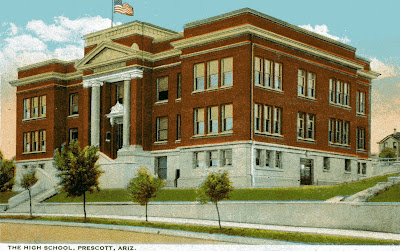
click to enlarge
I had several pictures of "The Big Snow" of 1967, but I could find only this one. It's of the collapsed roof of the Western Auto store located about the middle of Whiskey Row.
I was inspired to post this now because
Jarat at
Prescott Daily Photo has posted some nice snow photos including one taken of that snow.
In 1967, we were living in Groom Creek at an altitude of approximately 6000 feet, and the day it started snowing I was in town doing my once a week shopping. Snow wasn't that unusual in those days, but this time I noticed that the snow was falling in clumps rather than flakes, threatening to pile up in a hurry. I called the three other Moms in our neighborhood to see if they wanted me to bring their children from school when I picked up my older two who were in third and fourth grades. At that time, Groom Creek still had a school district, but there were so few children, they paid tuition to Washington School.
With my three year old son in tow, I made the rounds of elementary classrooms, taking the kids out about an hour early, bundling them up, and herding them to the truck.
Then I was carefully steering our old pickup packed with nine kids, the youngest in front and oldest in back, up the steep, curved, already snow covered road toward home. (that would be illegal today of course, perhaps rightly so) As I dropped the last of my charges, I noticed the chunks falling from the sky had reached huge proportions, and I was relieved when we made it around the bend and up the steep hill of our driveway where the truck then sat immobilized for about a week.
We were snowed in for eleven days, getting out one time to get into town for groceries and a little Christmas shopping. There was propane in the tank, but it was far from full, so we set the thermostat at sixty degrees and used the fireplace for extra heat. The electricity went off early on and without the electric stove, I cooked in a dutch oven in the fireplace. We melted snow in pans set around the fireplace for drinking water. While many people lost phone service, we were fortunate to have ours most of the time.
At that time, Groom Creek was still primarily a community of summer homes and we got calls from concerned neighbors. One offered a huge woodpile (gratefully accepted) another, the location of their spare key and the contents of their freezer (gratefully declined), and one permanent neighbor who happened to be vacationing in Florida called to say, "If you need booze, break a window!" (gratefully, kept in mind.)
It happened that Disney was filming a movie, something about Ostriches, in Mayer or Dewey. The film crew was renting a lovely old house that had once been an old stage stop, but one cameraman, with his family, rented a house fairly close to us. He was an intrepid athlete who happened to have his skis with him. It was a blessing for a permanent resident, the eighty- three year old author Walt Coburn a diabetic, as the cameraman who skied to town daily, brought back insulin as well as food to keep his film crew buddies going.
One of my worries was our Shetland pony, Cupcake. Although she was covered with thick woolly coat I fretted because she refused to go into her stall to stay dry. At some point during the storm, the snow turned wet and slushy. I worried that Cupcake would turn into an icicle. Out we went to shovel out three or so feet of corral gate, feed room, and shop so that we could put the feed into the shop and Cupcake into the tiny feed room. There was a partition between the feed room and the stall with a manger on the stall side. The next morning, we found a bone dry Cupcake in the corral. She had clambered up over the three or four foot partition, through the manger into her stall. I still think we saved her, as that morning, all the trees were uncased in ice and limbs were crashing down everywhere.
We had cut our Christmas tree a week or so before the snow started, so we brought it in and decorated it in it's usual front window setting. The day we got out to shop the electricity was still off, but when we rounded the bend just at dusk the tree was shining out from it's place in the front window, lights reflected off the snow, with all the radient beauty of Christmas.
When the second storm hit we were snowed in again for about another week, but the roads were cleared by Christmas day.













